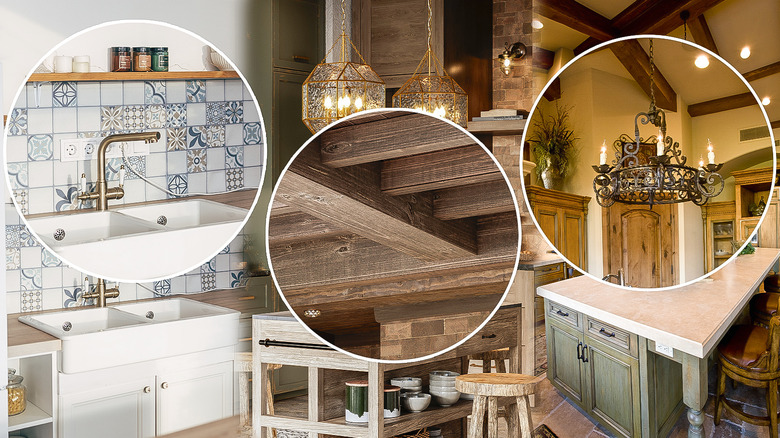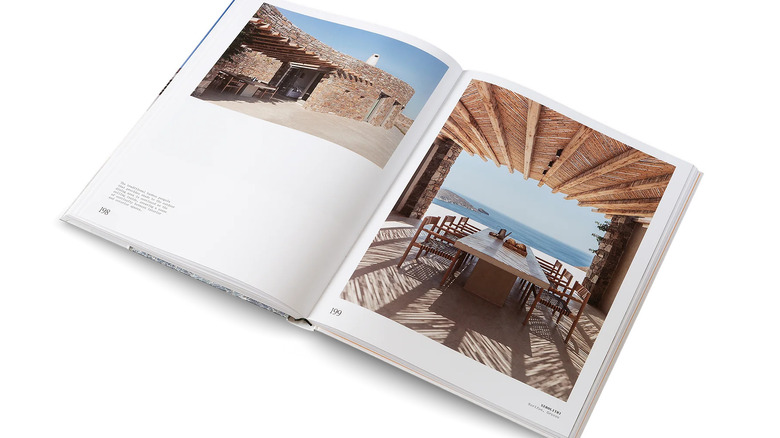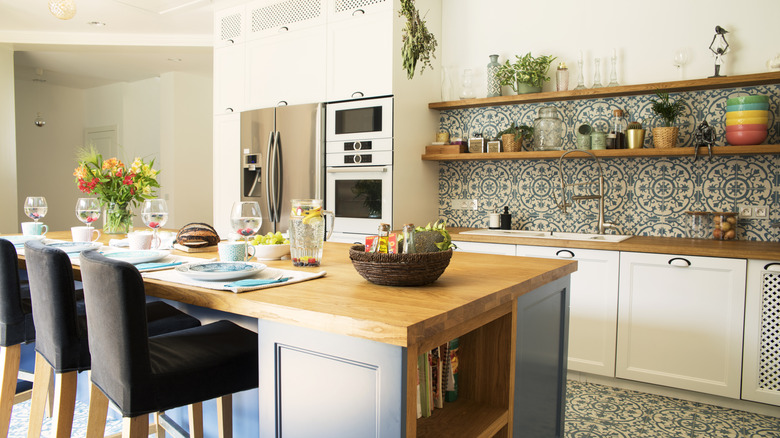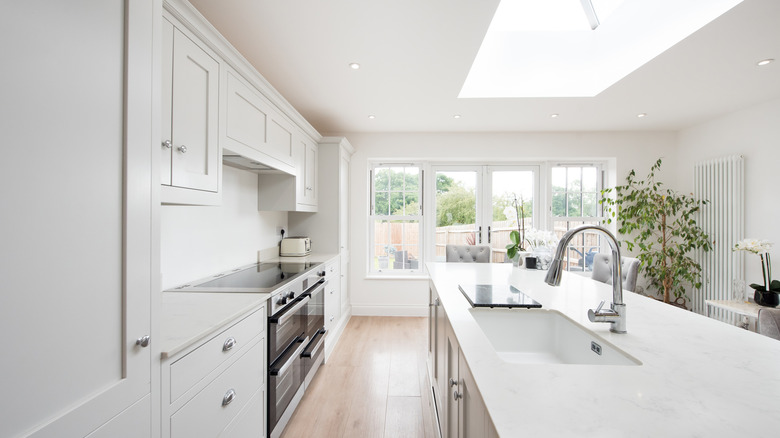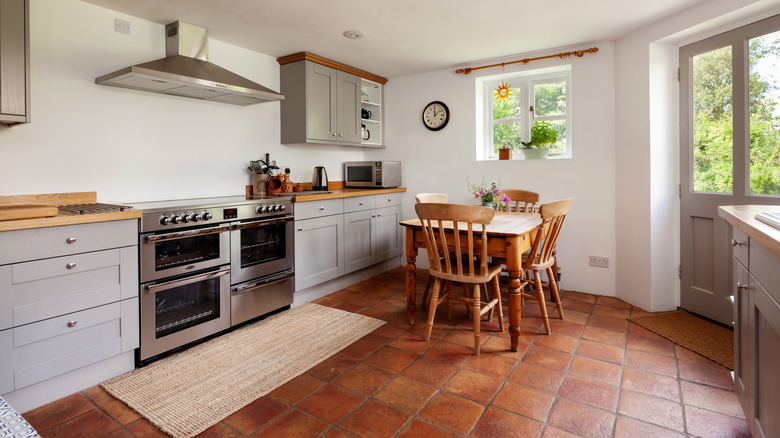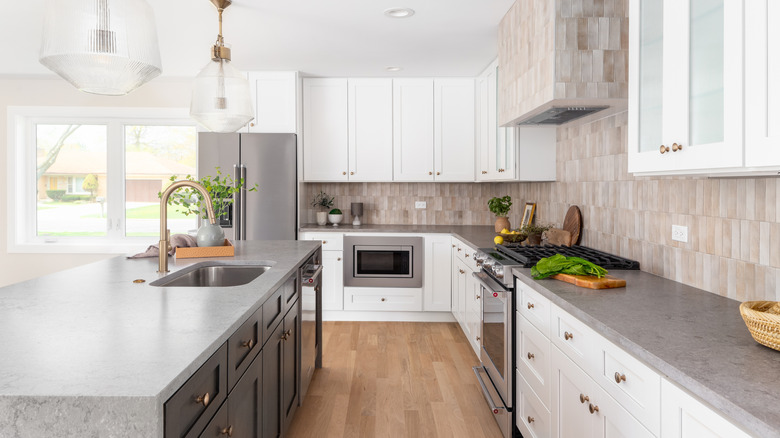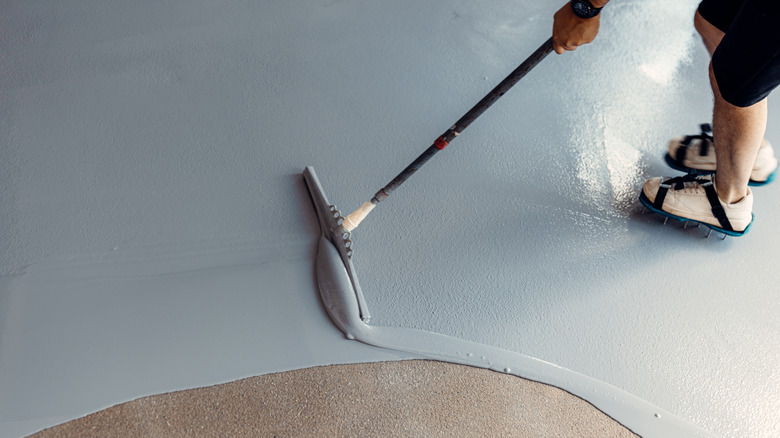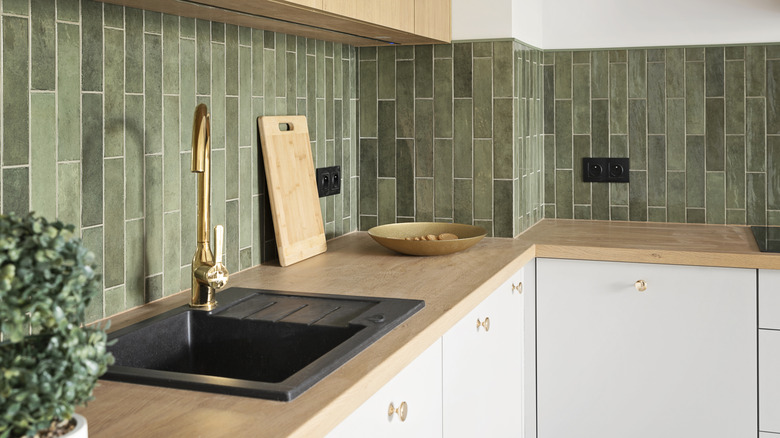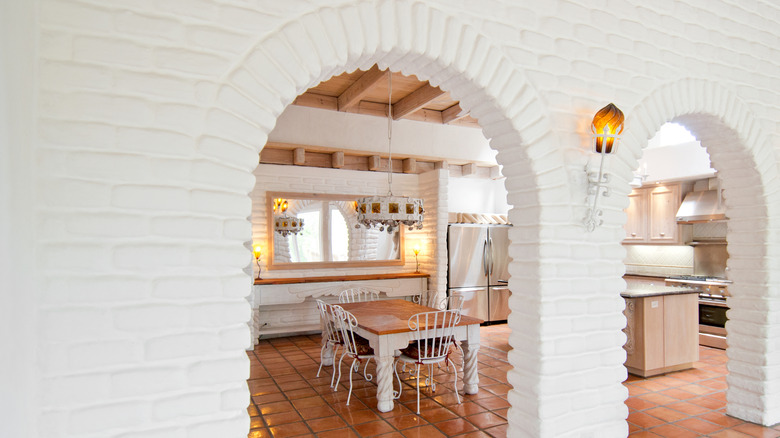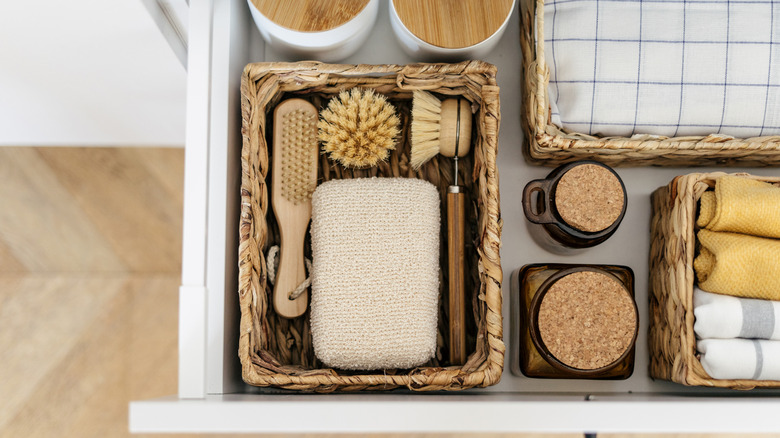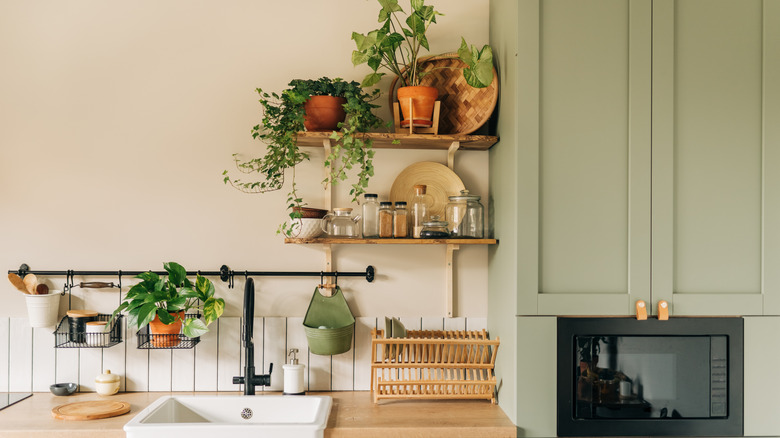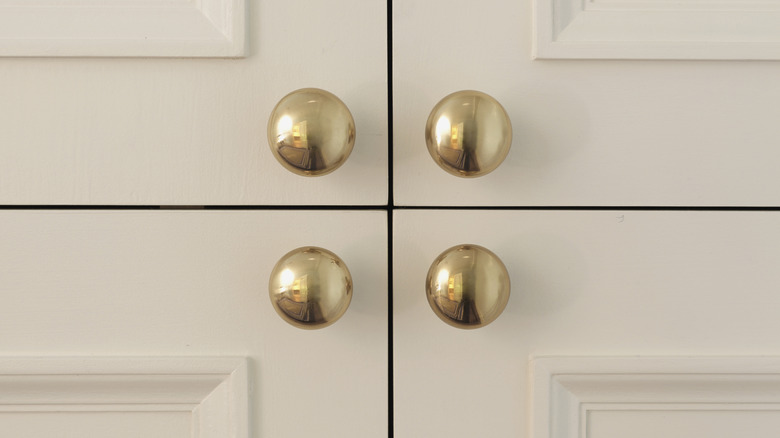12 Tips For Designing A Mediterranean-Style Kitchen
There is something about the notion of Mediterranean-style design that evokes idyllic notions of serenity and calmness. Pinning this interior design down to one definition, however, isn't quite as easy. You'll find that Mediterranean design borrows the love for natural materials and warm colors from rustic designs, but it isn't entirely rustic. Coastal elements can also be found here, but Mediterranean style can't be pigeonholed as simply coastal, either.
Instead, you'll find that Mediterranean design leans on elements from several interior styles to devise a cohesive vision for indoor-outdoor living. Inspired by life along the Mediterranean coast, terracotta and tranquility can be found in equal measure here. Natural materials, rustic textiles, and earthy hues abound with a whisper of sea breeze around every corner.
If you are ready to transform your kitchen into a soothing sanctuary but are not sure where to begin, we called upon help. Monica Gounaropoulos, founder of Spiti Interior Design, wants you to know that getting started is easier than you think. From choosing the right colors to adding the perfect coastal finishing touches, her round-up of Mediterranean-style kitchen tips will help transport your dinner guests to a seaside haven — no passport needed.
Look for design inspiration
It all begins with an idea, a fleeting spark of inspiration, or even a feeling. Perhaps, you are looking to recreate the summer you spent in an idyllic Grecian villa. Or maybe you'd like for your kitchen to feel like summer all year round. Once you have a concrete idea of what you want the final space to feel like, you will find it easier to start pinning ideas on your mood board.
Not quite sure where to begin? Coffee table books can prove to be a potent treasure trove of inspiration. For getting to the beating heart of Mediterranean design philosophy, Monica Gounaropoulos personally loves flicking through "The Mediterranean Home" by Gestalten. "It provides a stunning look at a variety of Med homes across the region which have style commonalities," she says, "but also regional variations which speak to their own geographical positioning." With a closer look at the finer nuances of Mediterranean-inspired interior design, decor, and furniture, the book serves as a helpful guide for turning your kitchen into a breezy Mediterranean haven.
Your quest for inspiration doesn't have to end there, either. Curating ideas on websites, like Pinterest, is a free and easy way to start. Celebrities, like Ellen Pompeo of "Grey's Anatomy" fame, have been known to champion the pared-back elegance of Mediterranean-style living into their sprawling residences. Within Pompeo's villa in the Hollywood Hills, you'll find several details worthy of being bookmarked, from reclaimed Provençal tiles to Moroccan mirrors and furnishings.
Opt for an open layout
According to Monica Gounaropoulos, the essence of Mediterranean cooking lies in being social. In her rulebook of Mediterranean-style kitchen tips, the layout needs to be designed as an open plan space that connects with the dining or living space. Cooking up a marvelous feast and entertaining guests then becomes a seamless experience. "The layout should be welcoming, warming, and casual," she affirms.
Start designing the Med-inspired kitchen of your dreams with a central island or a galley design that allows you to interact with guests without any intrusions while preparing food. The choice between the two can be driven by your priorities. If you like having ample workspace as you let your culinary juices flow wild, a kitchen island makes for a no-brainer. A galley layout, meanwhile, offers up two parallel countertops that are ideal if you have more than one person cooking at a time.
Gounaropoulos also recommends adding in a breakfast bar or clustering stools around a U-shaped island, so your guests can linger leisurely as you cook. If a freestanding breakfast bar has long been a wishlist item, you'll want to opt for strategic decisions to make it a reality. In terms of material, quartz, marble, and granite all make for durable options. As the finishing touch, you can choose to add in LED strip lighting along the underside of the countertop to create that relaxed, stay-a-little-longer ambiance.
Avoid bold colors
If your mind leaps to sun-drenched vistas when you think of the Mediterranean, you are not the only one. Based on the concept of indoor-outdoor living, Mediterranean-style kitchen tips are often anchored around natural materials and aquatic hues. Unsurprisingly, heavily saturated colors that are harsh on the eyes have no business here. An overabundance of moody hues, such as black, can also detract from the breezy coastal sanctuary you are aiming for. If you do feel partial to the color, you can always choose to inject it through intentional accents, such as a baroque chandelier above the kitchen island for anchoring the space.
"What we're looking for in a Med kitchen is a light, natural, easy, and balanced feel to the space," Monica Gounaropoulos says. When designing a kitchen in this interior style, it helps to train your mind to think in terms of natural materials and a neutral palette for the foundation, from whites to earthy tones. "Any colors which you naturally see in your environment, you can bring in," she says.
Another popular candidate for Mediterranean kitchens is, unsurprisingly, coastal blue. The popularity of this color within this style of kitchen design won't require a massive leap of imagination. "When you think of the Med, you think of the sea," Gounaropoulos chimes in. Including strategic pops of coastal hues in your kitchen, through the cabinetry or the backsplash, can instantly transport your dinner guests to the sun-soaked landscape of the Mediterranean.
Choose natural materials
Moving beyond the polished lacquer of contemporary kitchens, Mediterranean design embraces a sense of curated calm. This design philosophy is most visibly manifested in the ways that it romanticizes the weathered charms of natural materials. Monica Gounaropoulos finds that wooden beams and exposed stone walls can serve as the focal point of the room. Whether used all over the kitchen or as an accent wall, the ridges, imperfections, and recesses in the texture of stone can lend an organic feel to the space. Complete the effect by opting for natural quartz countertops and warm-toned lighting to turn every meal into a homely affair.
There are several options to play around with in terms of tiles as well. When looking for earthy materials, you will find that terracotta can infuse understated elegance into your kitchen for a vibe that feels effortlessly Mediterranean. Embrace this warm hue in your countertops and cabinets, or invite its homey charms into your flooring. When glazed and sealed adequately, it can serve as a timeless option that is resistant to water damage and food stains.
Beyond the hard surfaces, Gounaropoulos also wants you to focus on the soft finishes that can also lend impact to your kitchen design. "Think soft linens, jute, straw, and woven rugs. It all sings to the same tune to create an overall feeling," she says.
Keep the countertops light
Given the precious real estate that countertops occupy, they can play a major role in dictating the ambiance of your kitchen. Get your design process started by gaining a deeper understanding of all the different kitchen countertop materials to choose from. You can then refine your search by opting for light or earthy colors. Monica Gounaropoulos has found that natural stone makes for a worthy candidate for Mediterranean countertops, while granite serves as a durable option as well. Known to be more resistant to high temperatures, stone countertops can stand up to the wear and tear that kitchens are subjected to everyday — making them a long-term investment that can last a lifetime when cared for properly.
If you are looking to infuse some luxury into your space, Gounaropoulos believes that marble is a worthwhile option. Beyond silently upping the resale value of your home, marble can last for 100 years with vigilant maintenance. However, it can stain easily, so you won't want to leave any food splatters sitting on its surface for too long.
Travertine is another material that ranks high in Gounaropoulos' book, and it is easy to see why. As a natural limestone formed around geysers and mineral springs, travertine has the same marbling effect as marble but is a cheaper option than its more elite cousin. However, since it is a porous material, it requires sufficient care against food spills in daily use.
Try microcement flooring
From food spills to foot traffic, flooring bears the majority of the brunt in the kitchen. When choosing the right candidate for your Med kitchen, your search will need to be guided by options that can offer functionality as well as aesthetic appeal in equal measure.
Fortunately, you won't have to look too far for answers. Monica Gounaropoulos has been observing an uptick in interest around microcement for walls and floorings. Applied as a thin layer of decorative coating measuring less than 3 millimeters, microcement makes for an easy upgrade to your existing kitchen flooring. This flooring stays resistant to everyday abrasions as well as cleaning products, making it a durable option for the long run. Natural materials, such as wood, pops of greenery, and minimalist furnishings work well for this flooring. The latter is easy to adopt if you have this guide to minimalist kitchens at hand.
The raw, organic appeal of Mediterranean kitchens also works well with wood flooring, according to Gounaropoulos. Wider planks can offer a streamlined look, while reclaimed wood is also gaining popularity for dialing down the impact on the environment. When shopping for yours, consider choosing white oak with a light grain that will prove to be resistant to moisture, or light maple that will serve as a durable workhorse in the kitchen.
Choose tiles in aquatic colors
From the backsplash to wall accents, tiles offer up myriad uses in the kitchen — but how do you tap into their versatile virtues without making the space look too contemporary? The answer lies in aligning this vital element within the larger umbrella of Mediterranean design.
Monica Gounaropoulos finds that using aquatic tiles in the backsplash can serve as a statement-making feature in a Mediterranean kitchen. The classic subway tile is now considered an outdated kitchen trend, but you can always give this design an upgrade by opting for aquatic hues — your options range from iridescent frosted glass tiles to mosaic-style arrangements. Fish scale tiles, with its signature scallop shape, can also evoke fond memories of the ocean breeze when doused in an ombré of teals and minty greens.
For tile flooring, Gounaropoulos favors beach-inspired ceramic tiles as a foundational element for that sand-in-your-toes vibe every morning. Look to wooden-effect porcelain tiles for a low-maintenance alternative to actual hardwood planks. Travertine also makes for a non-slippery option that is ideal for areas with a higher concentration of moisture and humidity, such as the kitchen. Choose yours in the muted hues of ivory or beige for completing the look.
Keep the walls neutral
Once you have laid down the foundational basics of your flooring and countertops, it is time to morph your walls into the perfect backdrop for island-inspired living. Monica Gounaropoulos finds that neutral walls will offer you the shortest route to accomplishing this mission, offering a minimalist-chic backdrop that will endure for generations to come.
The memo? Think coastal calm meets timeless charm. White-washed walls will instantly transport you to Mykonos, and she believes that subtle earthy hues are also worthy of being explored. If you like a touch of texture on your walls, stucco walls are another prominent hallmark of Mediterranean architecture that you may want to invite into your kitchen. With higher resistance to everyday wear and tear, this flame-resistant material makes for a wise choice for the high traffic that the kitchen witnesses on an everyday basis.
If you have been noticing some telltale signs that your kitchen needs a larger remodel, Gounaropoulos recommends adding arches to the foundation to truly embrace the Mediterranean spirit. This design works well for doorways and entrances, and you can also choose to add arched room dividers to separate the kitchen from the dining area. Looking for something a little less dramatic? Dip your toe in the water with arched windows to allow natural light to flirt with every corner of the kitchen.
Choose lighting fixtures with earthy finishes
Modern kitchens no longer rely solely on overhead lighting fixtures, but you probably knew that already. Once you have sidestepped all the outdated kitchen lighting trends to avoid, it is time to consider which fixtures are worthy of a spot in your Mediterranean haven.
Lighting fixtures with natural finishes, such as stone, cement, or ceramic, all receive a nod of approval from Monica Gounaropoulos — bonus points if you can find options crafted or carved by hand. Wicker pendant lights and bamboo lampshades serve as an effortless way to keep the spirit of Santorini summers alive in your kitchen all year round. If you are feeling the love for vintage designs, allow a wrought-iron chandelier to occupy pride of place above the kitchen island.
Beyond mere aesthetics, lighting also has a functional role to play in the kitchen. A moveable lamp is the quickest fix for dealing with bad kitchen lighting, and within the Mediterranean kitchen, this design staple takes on a pop of color through hand-painted ceramics and mood-enhancing mosaics. While bright overhead lights are needed for enhanced visibility during high-precision tasks, such as chopping and cleaning, it also helps to add in a dimmer switch to lower the brightness of the light bulbs as needed. Beyond serving as an energy-efficient investment, it adds warmth to the ambiance when entertaining guests at home.
Add rustic decor
There is a certain warmth baked within the DNA of Mediterranean design. Functional decor is blended with rustic materials to impart a sense of lived-in elegance. Expect natural materials with an intentionally distressed finish to dominate your mood board.
So, what does this look like for your choice of decorative flourishes in the kitchen? Monica Gounaropoulos recommends that you start small by adding terracotta and ceramic vases with long stems to your countertop. Like what you see? Next, add in a handcrafted fruit bowl topped with fresh limes for that zesty, coastal feel. Ready to bring the Mediterranean truly home? Allow this breezy design to seep into every corner of your kitchen, from wooden chopping boards and stone-inspired kitchenware to authentic Mediterranean cookbooks propped up in arched alcoves.
Gounaropoulos also finds that natural linens can soften the space, so reach for table runners, napkins, and tea towels in hues of ivory and beige. Carry forward the same all-natural-everything memo to the rest of your decor by opting for an abundance of materials such as wicker, rattan, jute, and straw for your baskets and countertop organizers. If you are looking to add vintage charm to the mix, you'll want to work in your favorite flea market finds, from wrought-iron utensil racks to metal canisters.
Consider open shelving for a homey vibe
The allure of an open pantry is undeniable for Monica Gounaropoulos. After all, there is something about the sight of neatly labelled jars and spice canisters that can offer up that "family home feeling," as she dubs it. The lifeblood of Mediterranean cooking lies in this sense of warmth, and you will find that open shelving serves as the easiest way to infuse this feeling into your kitchen.
Wooden shelves work well for an open pantry, while wicker baskets and rattan storage bins will add rustic appeal to the space. Clutter can, however, derail your design vision, cautions Gounaropoulos. Stay one step ahead by routinely purging your shelves of any unwanted residents. Once done, organize the remaining items in small clusters and add a touch of greenery — how about an olive plant potted within a woven planter?
For those interested in a closed pantry, Gounaropoulos advises opting for a hidden door to maintain the clean lines of the kitchen and create a sense of fluidity. If your pantry regularly devolves into an unsightly tangle of condiments and seasonings despite your best organizational efforts, a hidden pantry tucked away behind a faux wall in the cabinet can serve as a discreet solution. "We want this seamless feeling where all elements work in harmony with each other," she says.
Opt for coastal finishing touches
To ensure that the Mediterranean design ethos is truly etched into every corner of your kitchen, it helps to opt for some strategic finishing touches to seal the deal. Monica Gounaropoulos loves displaying decorative plates on open shelving as a nod to how homes in the Med would actually adorn their walls.
The possibilities are endless. Framed prints and posters featuring coastal hues and motifs will have you dreaming of the warm Mediterranean waters. If your cabinet hardware could use an upgrade, you can choose to opt for ceramic or aged brass for vintage charm. Faucets are another commonly overlooked aspect for adding personality to the kitchen — the old-world charm of bronze reigns strong within Mediterranean design. Gounaropoulos is also a fan of hand-woven table runners. For maximum impact, you can choose to complement yours with coordinated tea towels featuring summer-ready motifs.
An abundance of natural light is another crucial cornerstone of Mediterranean design. If you have windows in your kitchen, you will need to ensure that you aren't stifling them with heavy weaves. Instead, opt for sheer white curtains that will maximize natural light and flirt with the wind as the perfect finishing touch to your Mediterranean kitchen.
